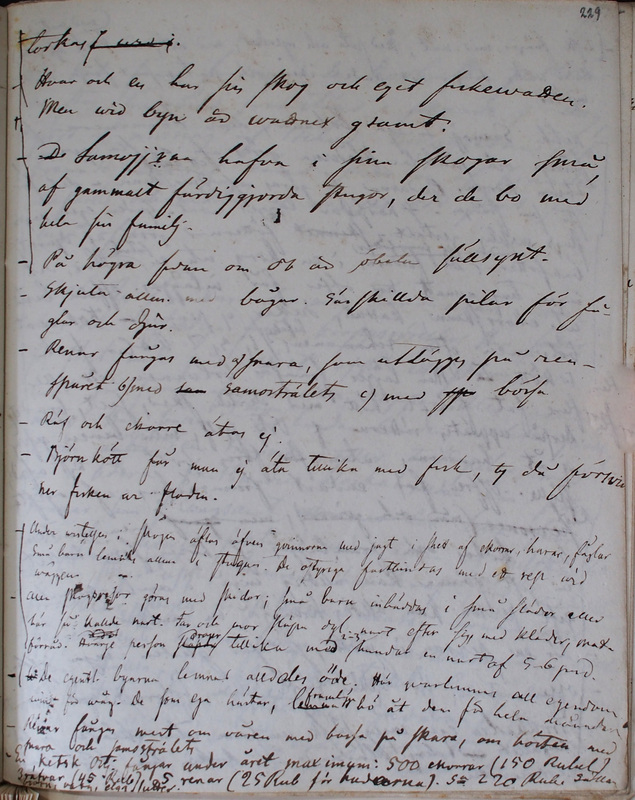Ethnographiska, historiska och statistiska anmärkningar. 229
Title
Description
|
torkas Hvar och en har sin skog och eget fiskwatten. sobeln
sällsynt. For an overview of hunting among the Selkups, see Tučkova 2005a: 322–325.
Skjuta allm. med bågar. Särskillda pilar för få- glar och djur. Renar fångas med a) snara, som utlägges på ren- spåret b) med samosträlets c)med bössa Räf och ekorre ätas ej. Björnkött får man ej äta tillika med fisk, ty då förs vinner fisken ur floden. Under wistelsen i skogen äflas äfven qvinnorna med jagt i skett af ekorrar, harar, fåglar Små barn lemnas allena i stugor. De ostyriga fastbindas med ett rep wid wäggen. Om skogsresor göras med skidor, små barn inbäddas i små slädor eller här så kallade nart. Far och mor släpa dyl[ik]. nart efter sig med kläder, mat- förråd. Hvarje person släpte drager tillika med 2-3 hundar en nart af 5-6 pud. De egentl[iga]. byarna lemnas alldeles öde. Här qvarlemnas all egendom <--> för wäg. De som ega hästar, lemna framlägga hö åt dem för hela månaden. Renar fångas mest om våren med bossa på skare, om hösten med snara och samosträlets En Ketsk Ostj. fånger under året maximum : 500 ekorrar (150 Rubel), 3 räfvar (45 Rub.), 5 renar (25 Rub för hudarna), Så 220 Rub. Sällan björn, varg, elgg, utter. |
are dried. Everyone has their own forest and their own fishing waters. But near the village the waters are shared. The Samoyeds have in their forests small cottages built a long time ago in which they live with their whole family. On the right side of the Ob, the sable is rare. They generally shoot with bows. There are special arrows for birds and animals. [Wild] Reindeer are caught with: a) a snare, which is laid on a reindeer track; b) an arbalest, or c) a rifle. Foxes and squirrels are not eaten. Bear meat must not be eaten together with fish, because the fish would vanish from the river. When in the forest, the women too hunt squirrels, hares, and birds. Small children are left alone in the cottages. The unruly ones are tied with a rope over their back. If forest trips are made with skis, small children are put in small sledges or what are here called narts. The father and mother drag similar narts with clothes and the store of food. Each person, together with two or three dogs, drags a nart of 5-6 pud. The actual villages are left completely desolate. Everything not needed during the trip is left there. Those who own horses leave them hay for the whole month. [Wild] Reindeer are mostly hunted in the spring with rifles on the snow, and in the autumn with a snare or arbalest. A Ket Ostyak catches during the year a maximum of: 500 squirrels (150 roubles), three foxes (45 roubles), five reindeer (25 roubles for the hides), altogether 220 roubles. Rarely, bear, wolf, elk, otter. |

